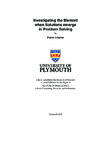Investigating the Moment when Solutions emerge in Problem Solving
| dc.contributor.supervisor | Bugmann, Guido | |
| dc.contributor.author | Lösche, Frank | |
| dc.contributor.other | School of Engineering, Computing and Mathematics | en_US |
| dc.date.accessioned | 2018-11-19T17:41:07Z | |
| dc.date.issued | 2018 | |
| dc.identifier | 10492991 | en_US |
| dc.identifier.uri | http://hdl.handle.net/10026.1/12838 | |
| dc.description.abstract |
At some point during a creative action something clicks, suddenly the prospective problem solver just knows the solution to a problem, and a feeling of joy and relief arises. This phenomenon, called Eureka experience, insight, Aha moment, hunch, epiphany, illumination, or serendipity, has been part of human narrations for thousands of years. It is the moment of a subjective experience, a surprising, and sometimes a life-changing event. In this thesis, I narrow down this moment 1. conceptually, 2. experientially, and 3. temporally. The concept of emerging solutions has a multidisciplinary background in Cognitive Science, Arts, Design, and Engineering. Through the discussion of previous terminology and comparative reviews of historical literature, I identify sources of ambiguity surrounding this phenomenon and suggest unifying terms as the basis for interdisciplinary exploration. Tracking the experience based on qualitative data from 11 creative practitioners, I identify conflicting aspects of existing models of creative production. To bridge this theoretical and disciplinary divide between iterative design thinking and sequential models of creativity, I suggest a novel multi-layered model. Empirical support for this proposal comes from Dira, a computer-based open-ended experimental paradigm. As part of this thesis I developed the task and 40 unique sets of stimuli and response items to collect dynamic measures of the creative process and evade known problems of insightful tasks. Using Dira, I identify the moment when solutions emerge from the number and duration of mouse-interactions with the on-screen elements and the 124 participants’ self-reports. I provide an argument for the multi-layered model to explain a discrepancy between the timing observed in Dira and existing sequential models. Furthermore, I suggest that Eureka moments can be assessed on more than a dichotomous scale, as the empirical data from interviews and Dira demonstrates for this rich human experience. I conclude that the research on insight benefits from an interdisciplinary approach and suggest Dira as an instrument for future studies. | en_US |
| dc.language.iso | en | |
| dc.publisher | University of Plymouth | |
| dc.rights | Attribution-ShareAlike 3.0 United States | * |
| dc.rights.uri | http://creativecommons.org/licenses/by-sa/3.0/us/ | * |
| dc.subject | Eureka Moment | en_US |
| dc.subject | Aha! moment | en_US |
| dc.subject | Architecture | en_US |
| dc.subject | CogNovo | en_US |
| dc.subject | Cognitive Innovation | en_US |
| dc.subject | Cognitive Science | en_US |
| dc.subject | Creativity | en_US |
| dc.subject | Design Thinking | en_US |
| dc.subject | Dira | en_US |
| dc.subject | Emergent Solutions | en_US |
| dc.subject | Epiphany | en_US |
| dc.subject | Experimental Psychology | en_US |
| dc.subject | Hunch | en_US |
| dc.subject | Ill-defined Problems | en_US |
| dc.subject | Illumination | en_US |
| dc.subject | Creative Problem Solving | en_US |
| dc.subject | Insight | en_US |
| dc.subject | Mixed Methods Approach | en_US |
| dc.subject | Multi-layered Model of Creativity | en_US |
| dc.subject | Problem Solving | en_US |
| dc.subject | Process-tracing Measures | en_US |
| dc.subject | Qualitative Data | en_US |
| dc.subject | Quantitative Analysis | en_US |
| dc.subject | Serendipity | en_US |
| dc.subject.classification | PhD | en_US |
| dc.title | Investigating the Moment when Solutions emerge in Problem Solving | en_US |
| dc.type | Thesis | |
| plymouth.version | publishable | en_US |
| dc.identifier.doi | http://dx.doi.org/10.24382/924 | |
| dc.rights.embargodate | 2019-11-19T17:41:07Z | |
| dc.rights.embargoperiod | 12 months | en_US |
| dc.type.qualification | Doctorate | en_US |
| rioxxterms.funder | Plymouth University | en_US |
| rioxxterms.identifier.project | Cognovo | en_US |
| rioxxterms.version | NA | |
| plymouth.orcid_id | 0000-0002-7780-6438 | en_US |
Files in this item
This item appears in the following Collection(s)
-
01 Research Theses Main Collection
Research Theses Main



